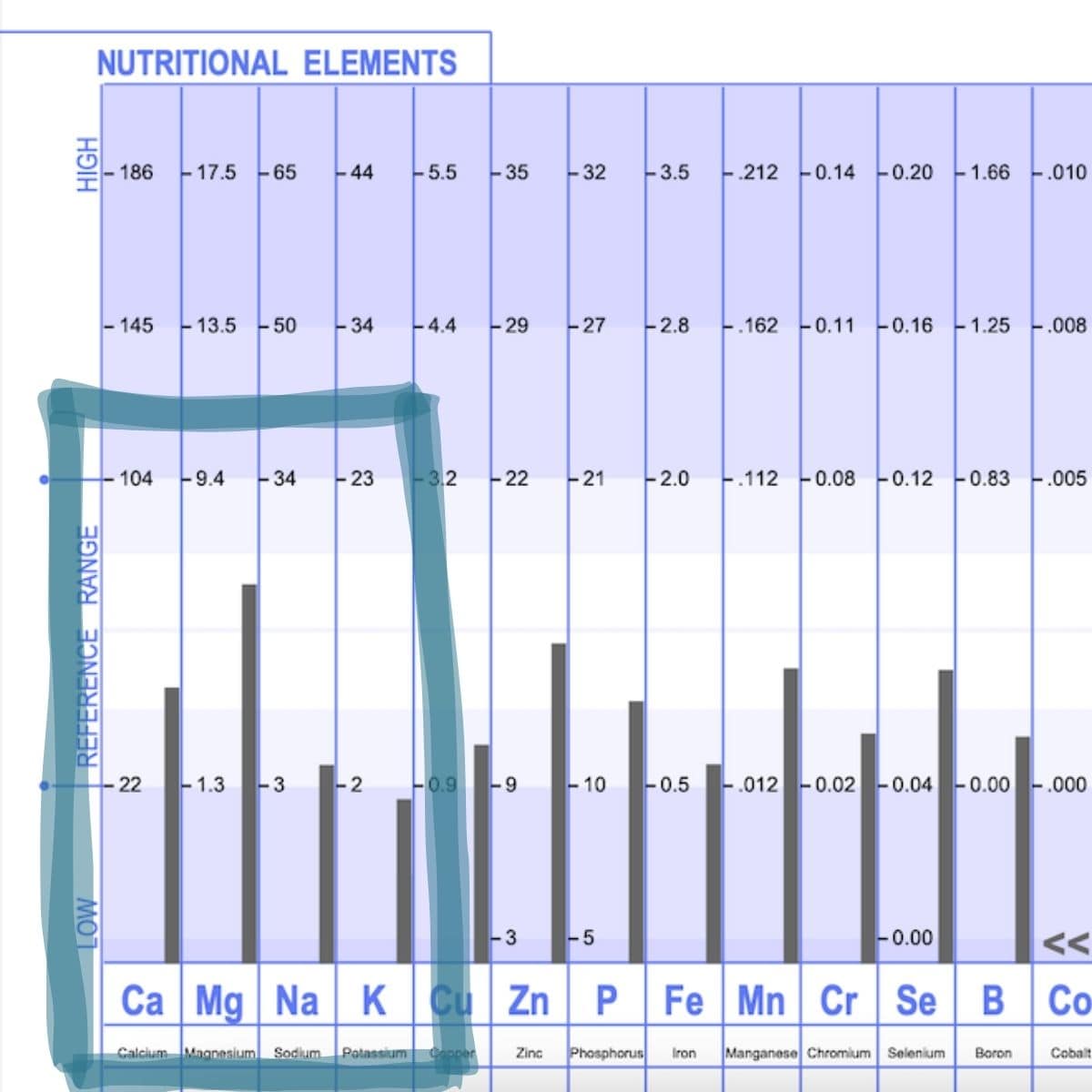Preventing Type 2 diabetes, Pre-diabetes, PCOS, and other diseases involves more than just watching your sugar intake. It’s about understanding your body’s intricate balance, which includes mineral levels that play a crucial role in blood sugar regulation. In this article, we’ll explore the Hair Tissue Mineral Assessment (HTMA) also known as Hair Mineral Analysis, and how it can be a powerful tool in preventing mineral and blood sugar imbalance.
What is the Hair Mineral Analysis?
In the medical world it is actually called a Hair Tissue Mineral Assessment (HTMA), it is a non-invasive hair mineral test that analyzes mineral and toxin content in your hair. While it may seem unconventional, hair mineral testing provides cellular level valuable insights into your body’s mineral status (beyond blood values!), including essential minerals like calcium, magnesium, chromium, and zinc that are directly linked to blood sugar balance.
Three Benefits of Hair Mineral Test Related to Blood Sugar Balance:
Early Warning System:
HTMA can detect mineral imbalances long before symptoms of blood sugar dysregulation appear.
- By identifying deficiencies in minerals like chromium (essential for insulin sensitivity) early on, you can take proactive steps to prevent Type 2 diabetes.
Personalized Nutrition:
HTMA results guide personalized dietary recommendations tailored to your specific mineral profile.
- With my expertise as a Functional Registered Dietitian, I can create a nutrition plan that addresses your mineral deficiencies, supporting optimal blood sugar levels.
Tracking Progress:
Regular HTMA assessments allow you to track changes in your mineral balance as you implement dietary and lifestyle modifications.
- This data-driven approach ensures your prevention strategy is effective and adjusted as needed.
The Power of HTMA in Hair Mineral Analysis Interpretation
What is the HTMA Process?
HTMA is a non-invasive diagnostic test that provides insights into an individual’s mineral status. Here’s how it works and why it’s a reliable indicator of mineral status:
Sample Collection: The process begins with the collection of a small hair sample, typically from the crown area of the head. Hair is preferred for analysis because it acts as a storage medium for minerals and other elements. This process can be done by you in the comfort of your home. Detailed instructions will be provided to you when you sign up for your testing HERE – Hair Mineral Analysis Test near me.
Mineral Extraction: Once the sample is received by the lab the hair tissue mineral analysis begins. The collected hair sample is then washed and prepared to remove any external contaminants.
Analytical Techniques: Advanced analytical techniques, such as inductively coupled plasma-mass spectrometry (ICP-MS), are used to determine the concentrations of various minerals and trace elements present in the hair sample.
Mineral Profiling: The results provide a comprehensive profile of an individual’s mineral status, including both essential and toxic minerals. It offers valuable data about macro minerals (like Calcium, Magnesium, Potassium, and Sodium) trace minerals (like Zinc, Copper, and Iron) and toxins or heavy metals (like aluminum and Mercury) just to mention a few.
Why HTMA is a Reliable Indicator:
Accumulation Over Time: Hair minerals accumulate over weeks to months, offering a broader perspective of an individual’s mineral status compared to blood or urine tests, which provide a snapshot of the moment.
Non-Invasive: HTMA involves a simple hair sample collection, making it non-invasive and suitable for individuals of all ages.
Reflects Tissue Mineral Levels: Hair minerals are considered to represent mineral levels in the body’s tissues, offering insights into long-term mineral imbalances.
Correlation with Health Conditions: Studies have shown correlations between hair mineral levels and various health conditions, making HTMA a valuable tool for identifying mineral-related health issues.
The Top 4 Macro Minerals that we look at in a Hair Tissue Mineral Analysis
Macro minerals are essential minerals required by the body in relatively large quantities. They play vital roles in maintaining overall health and well-being every second of the day.

1. Calcium (Ca):
Role in Blood Sugar Balance: Calcium is involved in insulin secretion and helps regulate blood sugar levels. It also influences the function of pancreatic cells that produce insulin.
Crucial for Bone Health: Calcium is a major component of bones and teeth, ensuring their strength and integrity.
Muscle Function: It is essential for muscle contraction, nerve transmission, and blood clotting.
2. Magnesium (Mg):
Insulin Sensitivity: Magnesium enhances insulin sensitivity, promoting better glucose uptake by cells and reducing the risk of insulin resistance.
Cardiovascular Health: It supports a healthy heart rhythm, blood pressure regulation, and vascular function.
Energy Production: Magnesium is a co-factor in many enzymatic reactions involved in energy production.
3. Potassium (K):
Blood Sugar Control: Potassium helps transport glucose into cells, contributing to blood sugar balance.
Heart Health: It plays a crucial role in maintaining normal heart rhythm and blood pressure.
Muscle and Nerve Function: Potassium is essential for proper muscle contraction and nerve signal transmission.
4. Sodium (Na):
Sodium-Potassium Balance: Sodium works in tandem with Potassium to maintain a proper fluid balance in and around cells, which is essential for nerve function and muscle contraction.
Blood Pressure Regulation: It influences blood pressure, and an imbalance can contribute to hypertension.
Nutrient Transport: Sodium is involved in transporting nutrients like glucose and amino acids across cell membranes.
Benefits of HTMA on Blood Sugar Balance
How HTMA Identifies Mineral Deficiencies Related to Blood Sugar Dysregulation Before Symptoms Manifest:
Hair Tissue Mineral Analysis (HTMA) is a powerful tool for identifying mineral deficiencies related to blood sugar dysregulation before symptoms become apparent. Here’s how it accomplishes this:
Reflecting Tissue Mineral Levels: When there’s an imbalance in essential minerals related to blood sugar regulation, it’s often mirrored in the hair.
Early Indicators: Even before overt symptoms of blood sugar dysregulation emerge, subtle mineral imbalances may be present in the body. HTMA can detect these imbalances, serving as an early warning system.
Predictive Value: Research has shown associations between certain mineral deficiencies and an increased risk of developing conditions like insulin resistance and Type 2 diabetes. HTMA can reveal these deficiencies and predict potential future health issues.
Comprehensive Mineral Profile: HTMA provides a comprehensive profile of various minerals, including macro minerals (such as Calcium, Magnesium, Potassium, and Sodium) and trace minerals (like Zinc and Chromium). Examining this full spectrum allows for a more accurate assessment of mineral-related factors in blood sugar regulation.

The Significance of Early Intervention in Preventing Type 2 Diabetes:
Early intervention based on HTMA results can be instrumental in preventing the onset of Type 2 diabetes. Here’s why it’s so significant:
Prevent Progression: Insulin resistance, a precursor to Type 2 diabetes, often develops gradually. Identifying mineral imbalances through HTMA provides an opportunity to address these issues early, potentially preventing the progression to diabetes.
Lifestyle Modifications: Armed with HTMA data, individuals can make informed lifestyle changes. This may include dietary adjustments, targeted supplementation, and lifestyle modifications to improve insulin sensitivity and blood sugar control.
Personalized Approach: Early intervention allows for a personalized approach to diabetes prevention. HTMA results can guide tailored dietary and nutritional strategies that specifically address an individual’s mineral imbalances.
Reduced Health Risks: By addressing mineral deficiencies before diabetes develops, individuals can reduce their risk of associated health complications, such as cardiovascular disease, nerve damage, kidney problems, and vision issues.
Enhanced Quality of Life: Preventing Type 2 diabetes not only reduces health risks but also enhances overall quality of life. It preserves physical and emotional well-being, as diabetes can significantly impact daily life and long-term health.
Additional Benefits of Hair Mineral Analysis on Overall Health
Mineral Imbalances and Beyond: While HTMA primarily assesses mineral imbalances, these imbalances often reflect broader health issues. For example, deficiencies in certain minerals may indicate nutritional inadequacies or imbalances that can affect overall well-being.
Systemic Impact: Minerals are involved in numerous biochemical processes throughout the body. Imbalances can disrupt these processes, impacting multiple systems. HTMA results can shed light on these systemic effects, even in areas unrelated to the primary reason for testing.
Early Warning Signs: HTMA can detect mineral imbalances before symptoms manifest. This early detection can serve as a warning sign for potential health issues, allowing individuals to take preventive measures and make necessary lifestyle adjustments.
Stress Reduction and Improved Well-Being
HTMA’s Role in Identifying Imbalances Related to Stress and Mood Disorders:
Chronic stress can deplete essential minerals in the body. HTMA can detect imbalances in minerals like Magnesium, Calcium, Zinc, and Potassium, which are closely linked to stress response and mood regulation.
Exposure to toxic elements such as lead, mercury, and cadmium, which can be assessed through HTMA, may contribute to mood disorders. These elements can disrupt neurotransmitter function and worsen mood symptoms.
HTMA can indirectly provide information about the availability of precursors for neurotransmitters like serotonin and dopamine, which play pivotal roles in mood regulation. Imbalances in minerals like Zinc and Iron can affect the synthesis of these neurotransmitters.
Strategies for Mitigating Stress-Related Mineral Imbalances and Achieving Better Emotional Well-Being:
Supplementation: Depending on HTMA results, targeted supplementation of deficient minerals can help restore balance. For instance, Magnesium supplementation may alleviate stress and anxiety symptoms.
Balanced Diet: Consuming a nutrient-dense diet rich in minerals is crucial. Foods like leafy greens, nuts, seeds, and whole grains provide essential minerals and support overall health.
Stress Management: Incorporate stress-reduction techniques into daily life, such as mindfulness meditation, yoga, deep breathing exercises, or progressive muscle relaxation. These practices can help mitigate the effects of stress on mineral balance.
Regular Exercise: Physical activity can positively influence mood and stress response. Exercise also supports mineral utilization in the body.
Limiting Toxic Exposures: Reduce exposure to toxic elements by avoiding sources such as contaminated seafood, lead-based products, and polluted environments. Filter drinking water and improve indoor air quality.
Gut Health: A healthy gut microbiome is linked to improved mood and stress resilience. Incorporate probiotics and prebiotic-rich foods to support gut health.
Professional Guidance: Consult with a healthcare professional, such as a Functional Registered Dietitian or a mental health specialist, to develop a personalized plan for addressing stress-related mineral imbalances and mood disorders.
Lifestyle Factors: Prioritize a balanced lifestyle that includes adequate sleep, social support, and time for relaxation and leisure activities.
Regular Monitoring: Periodic follow-up HTMA tests can track progress and ensure that interventions are effectively addressing mineral imbalances associated with stress and mood disorders.
In conclusion, HTMA can provide valuable insights into mineral imbalances related to stress mood disorders and prevent the progression of insulin resistance to diabetes type 2 and other conditions. Implementing strategies to correct these imbalances through supplementation, dietary adjustments, stress management, and a holistic approach to well-being can contribute to better emotional, and physical health and overall quality of life.
I am a seasoned healthcare professional, a Functional Registered Dietitian, and a Diabetes Specialist with over nine years of dedicated experience in the field.
My mission is to empower individuals on their journey to optimal blood sugar balance and overall health. Regardless of whether you have diabetes or not, working with me can be transformative for your well-being.
Get my Hair Mineral Test Kit today!
Learn more about My Diabetes Nutrition Services



